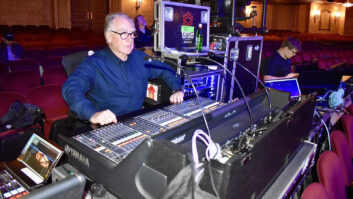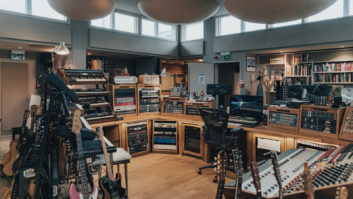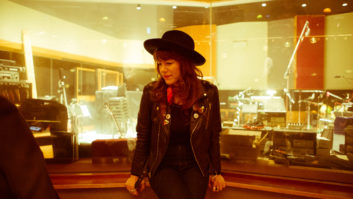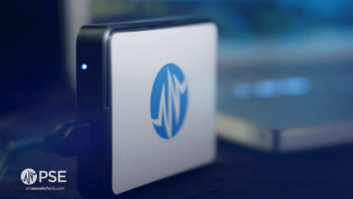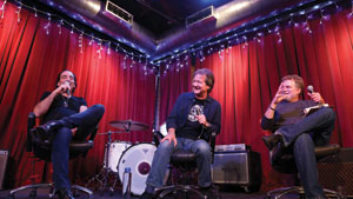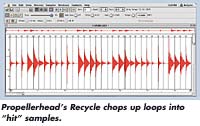
When we think of loop-based production, we often imagine techno anddance music or remixed pop hits — or in any case, music that’sbeen assembled loop by loop. But take a close listen to some of theR&B, hip hop and even rock that’s on the radio today, and you mightnotice the use of loops in the mix.
It used to be that “loop” was a dirty word, and for goodreason: The material available to build a loop was weak, technology waslimited and plenty of loops just sounded cheesy. But the popularity ofelectronic music has helped usher in a new generation of technologythat allows for more creative flexibility in any musicproduction environment. That, combined with the loop-heavy state ofmodern pop music, results in more music across the board that bringstogether loops and live audio tracks.
To gain a clear understanding of both the technical and creativesides of combining loops and audio tracks, Mix spoke withseveral well-known music producers and asked them to share some oftheir tricks. Producer/engineer/songwriter Michael Bradford (Kid Rock,Uncle Kracker, New Radicals) recently completed production on the newDeep Purple album Bananas (Sanctuary Records) and is about tobegin production on Uncle Kracker’s next album. Veteranproducer/songwriter David Frank has been churning out hits for morethan three decades, from Chaka Khan’s “I Feel for You” toChristina Aguilera’s “Genie in a Bottle” (which he co-wrotewith Steve Kipner and Pam Sheyne). Recent work includes tracks withEuropean pop star Ronan Keatings, American Idol runner-up JustinGuarini and a forthcoming American Juniors album. Joe Solo is aproducer/songwriter with Famous Music, the music publishing division ofParamount. His credits include Macy Gray and co-writes with JohnIngoldsby (Madonna and Elton John) and Arnie Roman (Celine Dion).

THE BIRTH OF A LOOP
Bradford explains that a well-chosen loop adds “spice”to a production that may be difficult to achieve with only an artist’sstudio performance. “The right loop will introduce a certainambience to a track, creating a mental picture of where you want totake the listener — whether it’s a busy city street, a dark alleyor some place more exotic. A good loop can really do a lotpsychologically for the listener and help you to tell a story with thesong. It’s like lighting in a visual setting: It helps set themood.”
A loop’s repetitive nature can also function as a production’srhythmic, and sometimes harmonic, glue. “The basis for allcontemporary groove-based music is one- or two-bar loops of repeatingrhythmic or harmonic patterns,” says Frank. “A loop cangive a track that hypnotic feel, which can be used to a producer orsongwriter’s advantage,” adds Solo, who will often loop a vocalline during the final chorus to underpin a song’s hook. Bradford adds,“The good thing about loops is that they have that steady time,while the bad thing is that they’re missing the human part of theequation — that spontaneous element of a performance. What makesa song that is heavily loop-based sound human is to have real fills andpercussion played over the loop — something to break up theloop’s repetitiveness.”
A loop can be added midway through a track, but it also can ignitethe creative process from the get-go. “There was a song I didrecently where I just keep repeating an organ riff over and over again,and the whole composition was built up from this loop,” saysFrank. Generally, a looped element, such as a rhythm track or obscuremelody from an old funk recording used during the songwriting process,will remain part of the final production even if the loop itself doesnot. As Solo puts it, “The loop may or may not end up in thefinal mix, but since the production was initially built using it as astarting point, the loop’s ‘feel’ stays with the song tothe end.”
During the course of a production, a loop may make its firstappearance at any time. Loops may be incorporated during thesongwriting process and remain through to the final mix or added aftera song has been recorded and carefully synchronized to theseperformances. Bradford says, “If I’m using a loop during therecording, it probably has a beat or a character that I want musiciansto key into as they’re performing the song. Otherwise, I’ll recordusing a click so that I can edit and fly sections around withoutworrying about tempo changes; this also gives me a tempo that I canrely on when I want to use my loops.”

HOMEGROWN ANDREADY-MADE
While there are numerous sample libraries on the market that offerquality loops, for the most part, these producers sample loops of theirown creation. “I’ll come up with some sort of sequence that Ilike,” says Frank. “This could be a rhythmic loop assembledfrom analog noise samples or a harmonic loop, like I might play afour-bar chord progression on a clavinet or Rhodes. Then I record theperformance into Logic Audio so that I have the loop as an audio file.That’s when the fun begins. In Logic, I work on the loop some more,filter it, chop it up and throw away the pieces that I don’t like.There’s a song called ‘Heartbreaker’ on Justin Guarini’sdebut album where I used this technique. I recorded a four-bar patternof arpeggiated chords using Emagic’s virtual Fender Rhodes, the EVP88.Then I changed the audio around in Logic. That loop is the harmonicunderpinning of the song.”
“I have a great drum kit, a ton of snares and a bunch ofpercussion instruments,” says Bradford. “Often, I’ll justgo into my studio, have a click running and record myself playing. ThenI’ll process the performances, do various things with ambience andecho, and burn loops out of them. I’ll also record individual drum hitsand then put everything together to build my own patternlibraries.” Bradford fashions loops from his guitar playing, aswell. “A lot of the loops I make are guitar that’s been heavilyprocessed, sort of repeating, sonic patterns. I have TC Electronic’sG-Force, a guitar processor with nine built-in effects — likecompression, delay, distortion, reverb, some filters — that canbe chained together in any sequence. And there are all sorts ofmodulation choices. It’s an incredible sound design tool that I’ve usedto make loops from guitar playing that sound nothing likeguitars.”
Solo takes a similar approach to creating loops. “In order tohave my own custom building blocks, I’ll sample my guitar playing andextract parts from my productions that haven’t been released. Then I’llspend time mangling these elements with plug-ins, effects units andeven stomp boxes, like wah wah and whammy pedals, to invent reallyunique-sounding loops.” Solo says that he has two “specialweapons” for processing loops: Antares’ Kantos and Roger LinnDesigns’ Adrenalinn II. “I love the Kantos plug-in. It can twistan audio file in really unconventional ways, and the results are alwaysoriginal. Adrenalinn is a groove-filter stomp box, which can impartthat classic, dirty loop feel to any instrument. I run instrumentsthrough it that aren’t usually associated with loops, from guitar tovocals and acoustic piano. It can even synchronize to MIDI Beat Clockfor some amazing rhythmic effects. I once spent six hours straightrunning a couple of looped vocal lines through Adrenalinn and exploringall the various possibilities.”
LOOP-LOCKED
But there are times when these producers employ loops from acommercially available library. For example, both Frank and Solo nameSpectrasonics’ Stylus as a drum loop source. Bradford also names a fewof his preferred CD-ROM releases: “One of my favorites isZero-G’s Chemical Beats,” he says. “And E-Lab’sVinylistic Series is always great to have on hand. I’ve usedthat one on everyone from Terence Trent D’Arby to Uncle Kracker. Oneother library is Big Fish Audio’s Alien Guitars. It’s reallygood for sounds that you don’t necessarily recognize as guitars; theloops just become ambience.”
“I recently did a production for American Juniors,where I used a loop from Stylus,” says Frank. “The trackneeded more of a swing feel, so I found a loop in Stylus that had theright type of feel. It was almost the right tempo as well, so ratherthan time stretch it, I simply tuned it to match the song’s tempo. Thesong’s original drums had sort of an eighth-note feel, while the loopfrom Stylus featured more of a swinging 16th-note feel. In this case,tuning the loop to lock it up with the original groove worked finebecause there were no conflicts between any of the parts. The loopadded the perfect feel for the final production.”
For those times when more drastic measures must be taken tosynchronize a loop, Solo employs Digital Performer’s built-in timecompression/expansion tool. “To change the tempo of one of myhomemade drum loops, I use Digital Performer’s graphic time-stretchingtool. Initially, you need to be meticulous about truncating the loop sothat it starts and ends perfectly in time, but after this, you can justgrab the end of the loop and snap it to your sequence’s tempo grid. Theloop is then automatically stretched or compressed to match the tempoof your song. I have the whole process down to about 20seconds.”
Bradford depends on Serato’s Pitch ‘n Time plug-in for histime-stretching tasks. “If it’s a matter of speeding up orslowing down the entire loop a significant amount, Pitch ‘n Time isgreat. A lot of percussion has pitches, and if you speed them up ordown, you don’t necessarily want the pitch to change, just the tempo.You can do this with Pitch ‘n Time.” When even more detailedediting is required, Bradford employs Pro Tools’ Beat Detective.“The Beat Detective feature lets me take any loop and chop it upinto smaller sections, which can then be quantized. Between Pitch ‘nTime and Beat Detective, I can pretty much line up anything withanything.”
Most loops are in 4/4 meter, but with a tool like Beat Detective andsome imaginative editing, it’s possible to lock a 4/4-meter loop into asong of a different meter. “On the Deep Purple album, there wasone song where the verses were in 7 and the choruses in 5,” saysBradford. “I found a very cool Latin percussion loop in 4/4, thenchopped it up to make it in 7. A lot of people think 4/4 time in termsof loops, but there’s no reason why you can’t do other time signatures.As long as you can get the loop to blend in so that you feel it butdon’t necessarily hear it.”
IN THE MIX
“The remake of Dobie Gray’s song ‘Drift Away’ onUncle Kracker’s No Stranger to Shame album is a good example ofhow I work,” says Bradford. “I cut the rhythm section withdrummer Russ Kunkel, one of the best drummers in the world; he playedon Jackson Brown’s ‘Running on Empty,’ Bob Seger’s‘Like a Rock’ and Carly Simon’s ‘Anticipation.’At that point, the song sounded very retro — too similar to theoriginal. So to give it a more contemporary sound, I decided to trysome loops, which really brought it into this century. The loops alonewould have been too youthful, too hip hop and not paid any respect tothe original version, which is one of the most popular songs of thelast 30 years. It was really the combination that made everything work.And it paid off. ‘Drift Away’ was Number One onBillboard‘s AC chart for a record 24 weeks, and the album wentGold largely on the strength of that single.”
All three producers often use filtering to help a loop sit in themix. As Solo explains, “I’ll filter out all the frequencies belowaround 5 kHz, leaving just the high end. That way, the loop’s kick andsnare won’t interfere with the real drummer’s performance. Thistechnique was used in Macy Gray’s ‘Sweet Baby,’ the firstsingle from The Id album, which was co-produced with Daryl Swannand Rick Rubin.” According to Bradford, “I’ll occasionallydrop a loop out during the mix, but I’m more likely to filter it. Thedownside with loops is that they take up so much room; if you take themout completely, you feel like the bottom has dropped out of the song.So rather than having a loop go away completely, filtering just changesits tone.” Frank also employs bit reduction. “The effect isto remove some of the loop’s bottom end so that it sits behind the maindrum groove.”
Processing the same loop in different ways, for different sectionsof a song, can also help to keep things interesting. For example, youcould lightly filter the loop during the verses, then put a phasingeffect on the loop for the choruses. Bradford says, “Anotherthing I do is use different kinds of loops, one for the verse, anotherfor the chorus and a different one for the bridge. To do this, you wantto select loops that are similar, but not exact, so switching betweenthem doesn’t sound abrupt. It’s the same idea as a live drummer whomight play one beat during the verse and, for more energy, a slightlydifferent beat during the chorus.”
Bradford offers some wise advice to integrate loops and livepercussion: “If you’re going to use loops against livepercussion, it’s very important to have a drummer who has really goodtime. Loops are so steady, they can really show any flaws in thedrummer’s timing. But when you have a drummer who can really play inthe pocket right along with the loop, it’s a magnificentsound.”
The right loop can add flavor to your production, and using a loopof your own creation will ensure that the flavor is not canned. As Soloputs it, “If you just stick with factory loops, you’re using thesame musical building blocks that everyone else in the world has accesstoo.” Don’t be afraid to experiment, because as Frank points out,“Playing with a loop in a digital audio sequencer is not unlikeworking with another musician: You can get different ideas from yourinterplay with the program.” Loops have become a staple inpopular music production. If you need proof, just look at the charts.So throw out any preconceived notions about what type of music loopsbelong in, and dig in.
Erik Hawkins was totally looped when he wrote this story. Lookfor his new book, How to Remix: Produce Dance-Floor Hits on YourPersonal Computer (coming next month from Berklee Press) to learnmore sizzling production tricks.
Prescription REX
With Propellerhead’s ReCycle application, loops can be chopped upinto component “hits,” where each hit becomes one sample.An associated MIDI file plays back all of the samples in order,re-creating the performance heard in the original audio file. These arecalled ReCycled loops. Such loops are often referred to by theirextension, .rex, for REX files. (There are actually two types of REXfiles: .rex, the original mono version, and .rx2, the more recentstereo version.) REX loops provide a high degree of tempo controlwithout any of the nasty artifacts normally associated with traditionaltime compression/expansion. Moreover, because of their uniquearchitecture, ReCycled loops can be easily quantized, re-grooved andeven rearranged.
Many of today’s top digital audio sequencers can read REX files,including Digital Performer, Logic Audio and Cubase SX. A handful ofother popular programs also work with REX files, includingPropellerhead’s Reason (the Dr. REX module) and Emagic’s EXS24 sampler.There are a lot of cool REX libraries available, but it’s also possibleto write your own REX files with the ReCycle application. With thisprogram in your loop-making toolbox, you can recycle your own loops tocreate the ultimate and totally flexible custom loop library.
Locking a ReCycled loop with the groove of a live performance is apiece of cake: By altering its MIDI performance file or the placementof each individual sample (as is the case when importing a REX filedirectly to an audio track), you can change the actual“feel” of the loop as easily as you can change its tempo.For example, you can create a groove template based on the drummer’sperformance and then quantize all of the REX files’ samples to thatgroove. This allows many loops that wouldn’t normally sound good on topof each other to be layered together because they are all locked to thesame groove engine.
— Erik Hawkins
